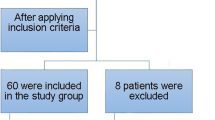Abstract
The loss of range of motion after anterior cruciate ligament (ACL) reconstruction is one of the most common and most challenging complications of this kind of surgery. Recently, an intercondylar notch fibrous proliferation, called cyclops syndrome because of its arthroscopic appearance, has been identified as one of the specific causes of loss of extension. The incidence of cyclops syndrome is 2%–4% [17, 18], but there is still no understanding of its etiology. We speculate on the etiology and suggest some technical solutions to reduce this complication. In 180 patients submitted to arthroscopic ACL reconstruction with patellar tendon, we observed in 4 cases a fibrous nodule adherent to the neoligament that caused a loss of extension between 12° and 17°. In all cases, arthroscopic removal of this nodule solved completely the loss of articular motion. The nodules were subjected to light and scanning electron microscope evaluation. We observed numerous, newly formed vessels in all 4 nodules. These vessels were made up of hyperplastic and hypertrophic cells and were surrounded by bundles of disorganized fibrous tissue. No inflammatory cells or bone or cartilaginous tissue was observed. We hypothesize a microtraumatic genesis for cyclops syndrome. Repeated microtraumas expose the graft collagen fibers, which can lead to productive inflammatory process and thence to the formation of the cyclops nodule. We suggest some technical solutions to avoid graft impingement with the notch and with the tibial bone tunnel.
Similar content being viewed by others
References
Bonamo JJ, Krinick RM, Sporn AA (1994) Rupture of the patella ligament after use of its central third for anterior cruciate reconstruction. J Bone Joint Surg [Am] 66:1294–1296
Branca A, Pedersini L (1994) Technique modification in ACL reconstruction with patella tendon. Oral communication, GIA, SIOT Congress, Firenze
Branca A, Delcogliano A, Franzese S (1996) The cyclops' syndrome in ACL reconstruction with Leeds-Keyo. Abstracts book, poster presentations 172, 7th ESSKA Congress
Cosgarea AJ, DeHaven KE (1994) The surgical treatment of arthrofibrosis of the knee. Am J Sports Med 22:184–191
DeHaven KE (1988) Complications of knee ligament surgery. Advanced Concepts in Arthroscopy of the Lower Extremity, Meeting of the American Academy of Orthopaedic Surgeons, San Diego
Enneking WF, Horowitz M (1972) The intrarticular effects of immobilization of the human knee. J Bone Joint Surg [Am] 54:973–985
Eriksson E (1986) Stalked patellar tendon graft in reconstruction of the anterior cruciate ligament. Orthopedics 9: 205–211
Fisher SE, Shelbourne KD (1993) Arthroscopic treatment of symptomatic extension block complicating anterior cruciate ligament reconstruction. Am J Sprots Med 4:558–564
Forman K, Jackson DW (1993) Cyclop's lesions. In: Jackson DW (ed) The anterior cruciate ligament: current and future concepts. Raven Press, New York, pp 365–372
Fullerton LR, Andrews JR (1984) Mechanical block to extension following augmentation of the anterior cruciate ligament, Am J Sports Med 12:166–168
Graf B, Uhr E (1988) Complications of intra-articular anterior cruciate reconstruction. Clin Sports Med 7:835–848
Greenfield MA, Scott WN (1994) The cyclop's syndrome in ACL reconstruction using ileotibial band. Am J Knee Surg 7:39–41
Hardin GT, Bach BR Jr, Bush JC (1992) Endoscopic single incision in ACL reconstruction using patellar tendon autograft: surgical technique. Am J Knee Surg 5:144–155
Harner CD, Irrigang JJ, Fu FH (1994) Loss of motion after anterior cruciate ligament reconstruction. Am J Sports Med 20:5–12
Heydorian K, Akbarnia B, Jabalameh M, et al (1984) Posterior capsulectomy for the treatment of severe flexion contractures of the knee. J Pediatr Orthop 4:700–704
Ishibashi Y, Rudy TW (1995) The effect of the ACL graft fixation level on knee stability. AANA 14th Annual Meeting, San Francisco, pp 151–156
Jackson DW, Schaefer RK (1990) Cyclops syndrome: loss of extension following intra-articular anterior cruciate ligament reconstruction. Arthroscopy 6:171–178
Marzo JM, Bowen MK, Warren RF, Wickiewicz TL, Altchek DW (1992) Intra-articular fibrous nodule as a cause of loss of extension following anterior cruciate ligament reconstruction. Arthroscopy 8:10–18
McCarroll JR (1983) Fracture of the patella during a golf swing following reconstruction of the anterior cruciate ligament. Am J Sports Med 11:26–27
Morgan CD (1996) The all inside ACL reconstruction. AANA, 1996 Atlanta speciality day meeting, pp 164–179
Mothadi NGH, Webser-Bogaert S (1991) Limitation of motion following ACL reconstruction: a case control study. Am J Sports Med 19:620–625
Nicholas GH, Webster-Bogaert S (1991) Limitation of motion following anterior cruciate ligament reconstruction. Am J Sports Med 6:620–625
Paulos LE, Rosenberg TD, Drawbert J (1987) Infrapatellar contracture syndrome: an unrecognized cause of knee stiffness with patella entrapment and patella infera. Am J Sports Med 15: 331–340
Payr F (1917) Zur operativen Behandlung des Kniegelenkssteige. Zentralbl Chir 44:809–813
Peacock EE (1966) Some biochemical and biophysical aspects of joint stiffness: role of collagen synthesis as opposed to alterated molecular bonding. Ann Surg 164:1–12
Sachs RA, Reznk A, Danier DM, et al (1990) Complications of knee ligament surgery. In: Danier DM, Akeson WH, O;Connor JJ (eds) Knee ligaments structure function injury and repair. Raven Press, New York, pp 505–520
Scott WN, Ferriter P, Marino M (1985) Intra-articular transfer of the iliotibial tract. J Bone Joint Surg [Am] 67:532–538
Small NC (1986) Complications in arthroscopy: the knee and other joints. Arthroscopy 2:253–258
Smillie JS (1973) Injuries of the knee joint, 4th edn. Williams & Wilkins, Baltimore, pp 365–386
Somerville EW (1959) Flexion contracture of the knee. J Bone Joint Surg [Br] 41:857–862
Sprague NE (1987) Motion-limiting arthrofibrosis of the knee: the role of arthroscopic management. Clin Sports Med 6:537–549
Sprague NF, O'Connor RL, Fox JM (1982) Arthroscopic treatment of postoperative knee fibrosis. Clin. Orthop 166:165–172
Author information
Authors and Affiliations
Rights and permissions
About this article
Cite this article
Delcogliano, A., Franzese, S., Branca, A. et al. Light and scan electron microscopic analysis of cyclops syndrome: etiopathogenic hypothesis and technical solutions. Knee Surg, Sports traumatol, Arthroscopy 4, 194–199 (1996). https://doi.org/10.1007/BF01567962
Received:
Accepted:
Issue Date:
DOI: https://doi.org/10.1007/BF01567962




